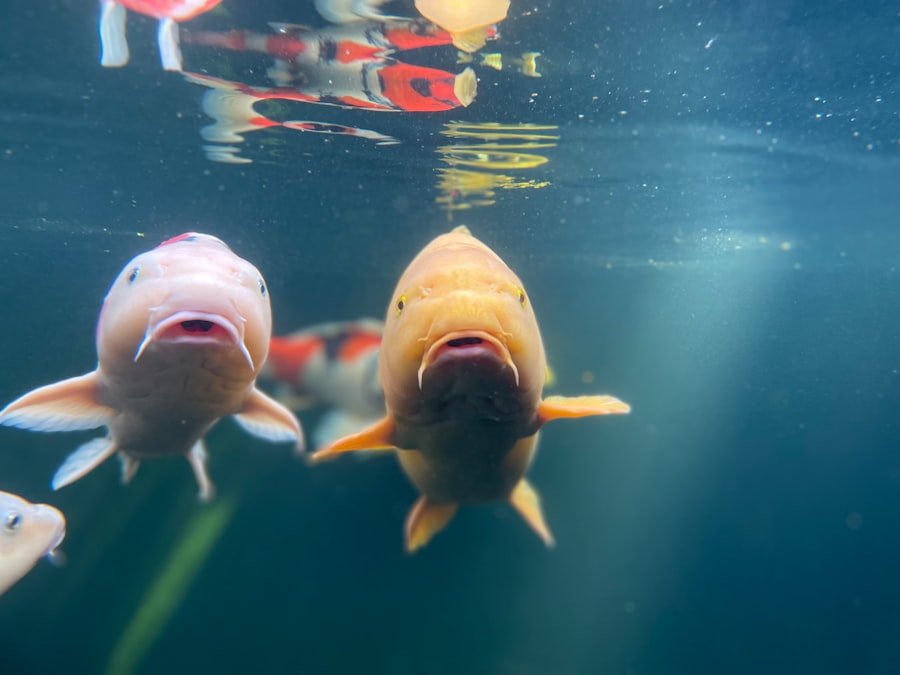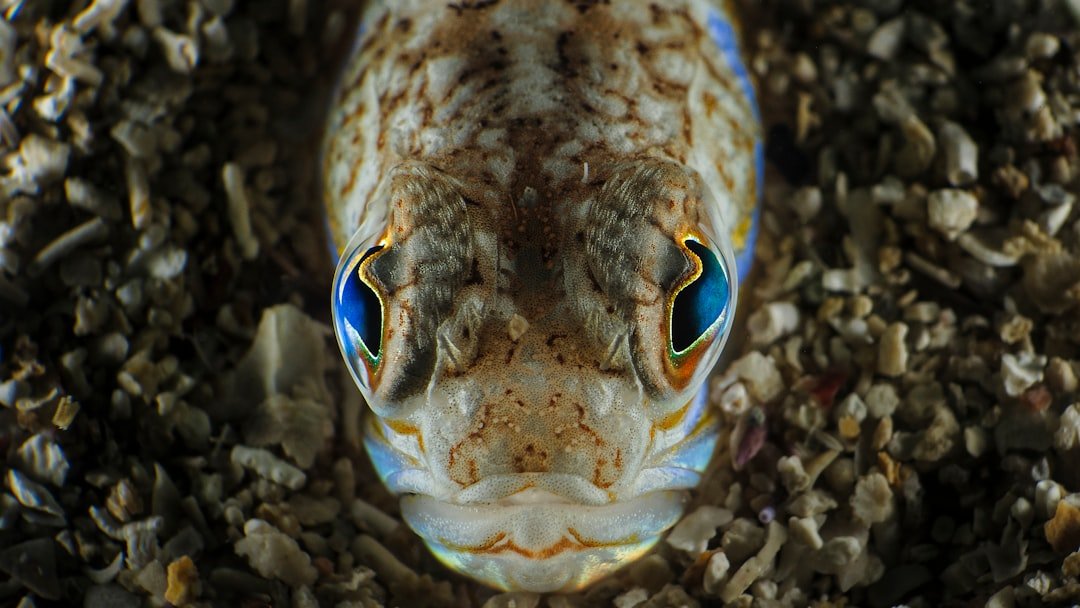Fish vision is a fascinating topic that has puzzled scientists for centuries. Fish have evolved unique visual systems that allow them to navigate and survive in their aquatic environment. In this blog post, we will explore the anatomy of fish eyes, the science of color perception, the role of light, and the challenges of seeing in water.
Key Takeaways
- Fish have a unique way of seeing the world that is different from humans.
- Understanding the anatomy of fish eyes is key to understanding their vision.
- Fish can see a wider range of colors than humans, including ultraviolet light.
- Light plays a crucial role in fish vision, affecting their ability to see and navigate.
- Fish have adapted to their underwater environment by developing unique visual abilities.
Understanding the Anatomy of Fish Eyes: The Key to their Vision
Fish eyes are similar to human eyes in many ways, but they have some unique adaptations. Like humans, fish have a cornea, iris, and lens that help focus light onto the retina. However, fish eyes have a spherical lens that allows them to focus on objects both near and far. This is because water is denser than air, so fish need a more powerful lens to refract light properly.
The retina of fish eyes contains specialized cells called rods and cones that are responsible for detecting light and color. Rods are more sensitive to light and are responsible for vision in low-light conditions, while cones are responsible for color vision. Some fish have more rods than cones, which allows them to see better in dimly lit environments.
The Science of Color Perception in Fish: How They See the Rainbow
Fish have a different range of color perception than humans. While humans can see a wide range of colors from red to violet, fish can see colors ranging from ultraviolet to red. Some fish can even see ultraviolet light, which is invisible to humans. This ability to see ultraviolet light can be useful for finding food or attracting mates.
The colors that fish see can affect their behavior. For example, some fish have bright colors on their bodies that they use to attract mates or intimidate rivals. Other fish have colors that help them blend into their surroundings and avoid predators. The ability to perceive color is an important adaptation that helps fish survive in their environment.
The Role of Light in Fish Vision: How Brightness Affects Their Sight
| Metrics | Results |
|---|---|
| Light Intensity | Directly affects fish vision and behavior |
| Color Spectrum | Impacts how fish perceive their environment |
| UV Light | Can be harmful to fish eyes and cause damage |
| Polarization | Helps fish navigate and locate prey |
| Light Cycles | Affects fish circadian rhythms and breeding cycles |
Light is essential for fish vision, but too much or too little light can be detrimental. Some fish have adapted to low-light environments by having larger eyes or more sensitive retinas. These adaptations allow them to see better in dimly lit conditions, such as deep-sea environments.
On the other hand, some fish have adapted to bright environments by having specialized pigments in their eyes that protect them from UV radiation. These pigments act as a sunscreen and help prevent damage to the retina. Without these pigments, fish would be more susceptible to eye damage from exposure to bright sunlight.
The Challenges of Seeing in Water: How Fish Adapt to Their Environment
Water is a complex medium that can distort light and make it difficult for fish to see. The way light behaves in water is different from how it behaves in air, which poses challenges for fish vision. However, fish have evolved various adaptations to overcome these challenges.
Some fish have eyes that are better at detecting movement or contrast, which helps them navigate through the water and find food. Other fish have adapted by using other senses, such as their sense of smell or lateral line, to navigate and find food. The lateral line is a series of sensory organs along the sides of a fish’s body that can detect changes in water pressure and vibrations.
The Diversity of Fish Vision: How Different Species See the World

There are over 30,000 species of fish, each with their own unique visual system. Some fish have eyes that are positioned on the sides of their head, while others have eyes that are positioned on the top of their head. The position of the eyes can affect how well a fish can see and what it can see.
Some fish have eyes that are adapted for deep-sea environments, where there is very little light. These fish have large eyes and are often bioluminescent, meaning they can produce their own light. Other fish have eyes that are adapted for shallow waters, where there is more light. These fish may have smaller eyes and rely more on color vision.
The Evolution of Fish Vision: How Fish Have Adapted to Survive
Fish vision has evolved over millions of years to help fish survive in their environment. Some fish have evolved to have better color vision to help them find food or avoid predators. For example, some reef fish have evolved the ability to see a wide range of colors, which helps them navigate through complex coral reef environments.
Other fish have evolved to have better night vision to help them hunt in low-light environments. These fish may have larger eyes or more rods in their retinas, which allows them to see better in dimly lit conditions. The evolution of fish vision is a testament to the adaptability and resilience of these incredible creatures.
The Use of Vision in Fish Behavior: How They Hunt, Mate, and Navigate
Fish use their vision for a variety of behaviors, such as hunting, mating, and navigating. Some fish use their vision to detect prey from a distance, while others use it to find a mate. For example, some predatory fish have excellent distance vision and can spot prey from far away. This allows them to plan their attack and increase their chances of success.
Mating behaviors in fish often involve visual displays. Male fish may display bright colors or patterns to attract females and compete with other males. Female fish may use visual cues to assess the quality of potential mates. Vision is also important for navigating through complex environments, such as coral reefs or kelp forests. Fish use visual landmarks to navigate and find their way back to their home territory.
The Impact of Human Activity on Fish Vision: How Pollution and Climate Change Affect Their Sight
Human activity, such as pollution and climate change, can have a significant impact on fish vision. Pollution can make it difficult for fish to see by reducing water clarity or introducing harmful chemicals. For example, runoff from agricultural fields can introduce pesticides and fertilizers into water bodies, which can affect the visual systems of fish.
Climate change can also affect fish vision. Rising temperatures can lead to increased algal blooms, which can reduce water clarity and make it difficult for fish to see. Changes in ocean acidity can also affect the visual systems of fish. For example, increased acidity can damage the cells in the retina and impair vision.
The Future of Fish Vision Research: How Science Continues to Explore this Fascinating Topic
Fish vision is a complex and fascinating topic that continues to be explored by scientists. New technologies, such as underwater cameras and genetic sequencing, are helping scientists better understand fish vision. By studying fish vision, scientists can gain insights into the evolution of vision and develop new technologies for underwater exploration.
Understanding how fish see the world can also have practical applications. For example, researchers are studying the visual systems of deep-sea fish to develop better underwater cameras that can capture images in low-light conditions. This research could also help improve the design of underwater vehicles and equipment used for scientific research or commercial purposes.
In conclusion, fish vision is a fascinating topic that has captivated scientists for centuries. Fish have evolved unique visual systems that allow them to navigate and survive in their aquatic environment. By studying fish vision, scientists can gain insights into the evolution of vision and develop new technologies for underwater exploration.
If you’re fascinated by the wonders of nature, you won’t want to miss this intriguing article on fish eyes. Discover the incredible adaptations and unique features of these underwater marvels. From their ability to see in low light conditions to their panoramic vision, fish eyes are truly remarkable. Dive into the world of aquatic optics and learn more about these fascinating creatures. To read more, check out this article on Just Tidings.




















+ There are no comments
Add yours